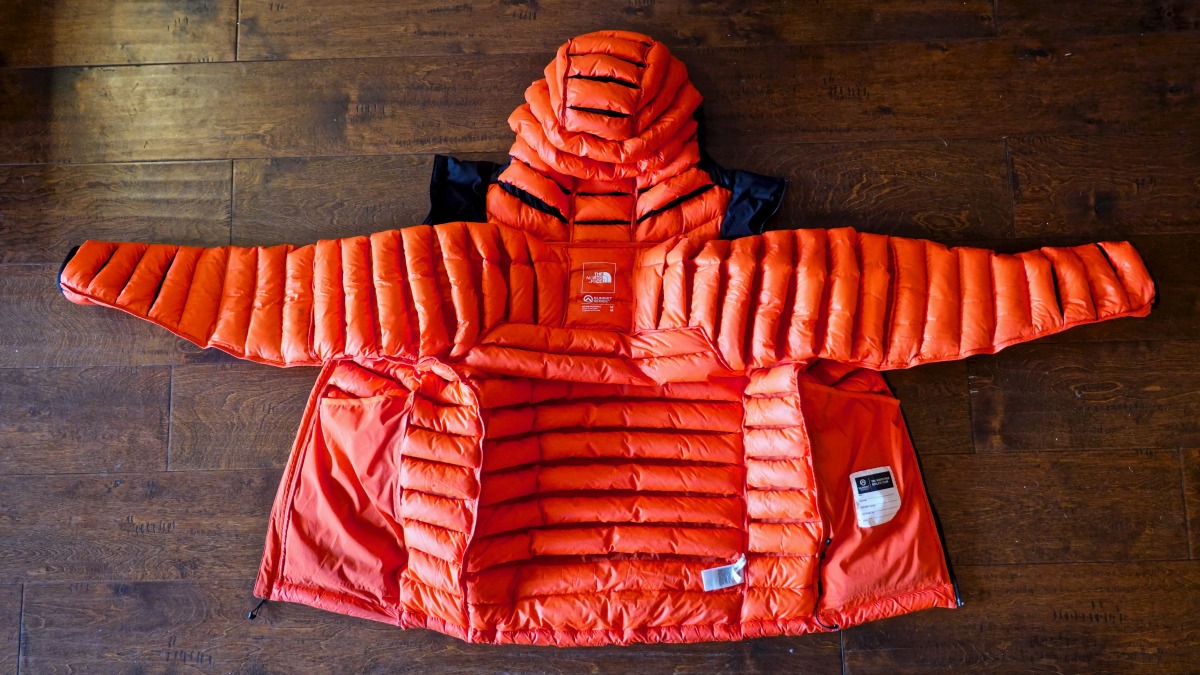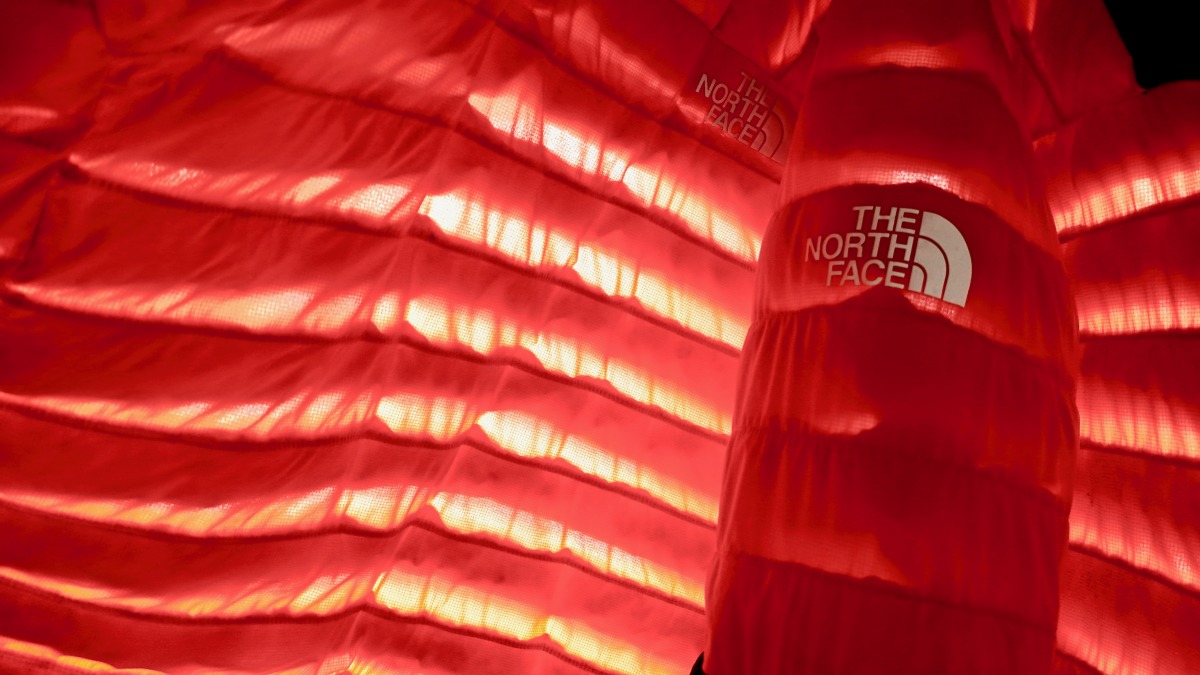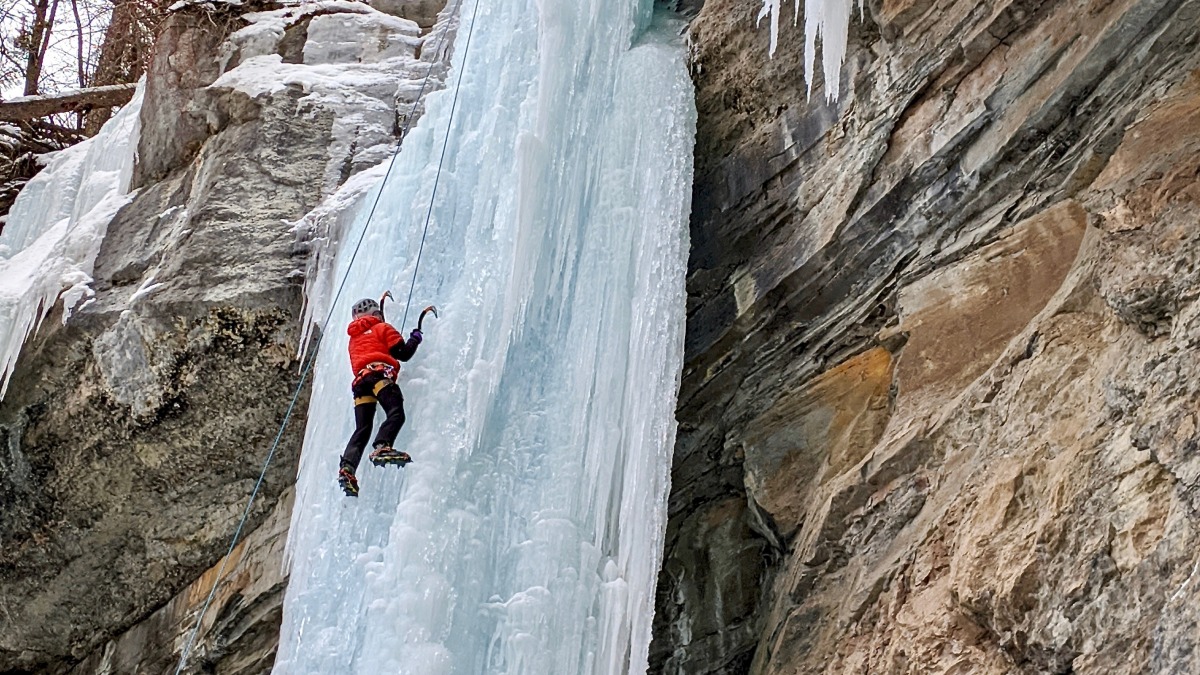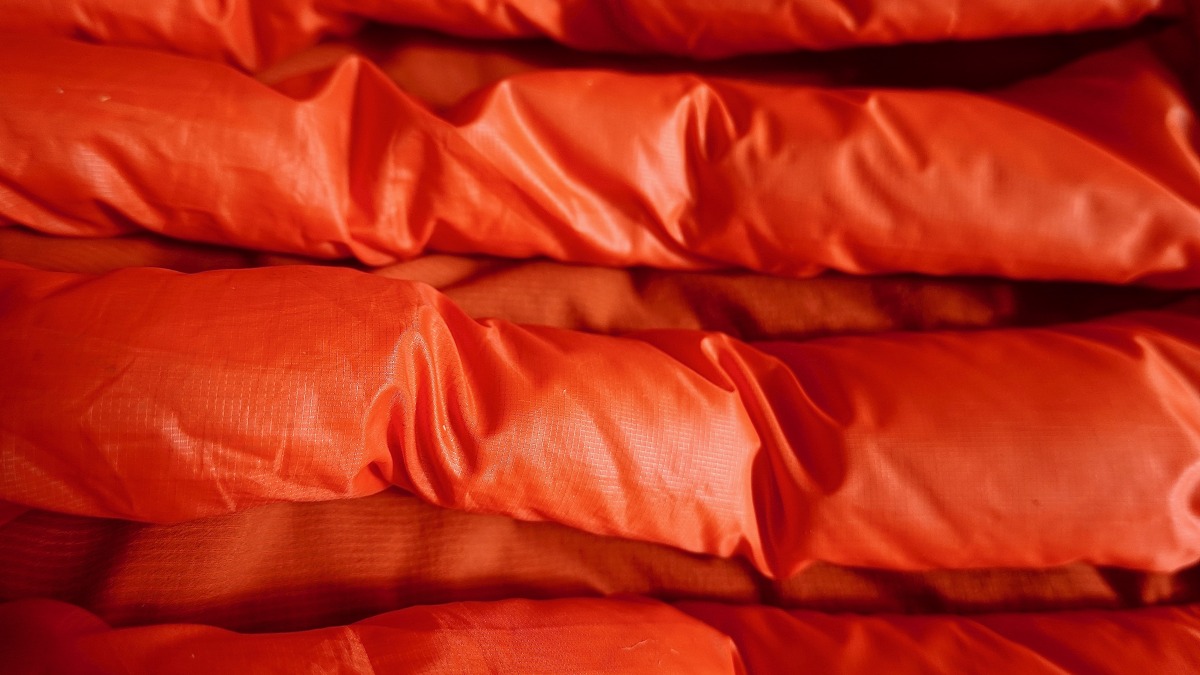
Inside view of The North Face L3 50/50, a successful attempt at a down insulation layer that breaths.
A down jacket not just for the summit
Good old baffled goose down is still one of the best insulators us humans have been able to come up with, especially when weight and size are in the equation. It has a high R-value per mass, and compresses well. Modern water repellent treatments to the down further enhance its ‘lofty’ place in the outdoor apparel and equipment world. The problem with this fowl material is that it must be contained by extremely tight woven nylon, all but preventing excess heat transfer and air permeation. This is fine in parking lots or cold ridges and descents, but not great for athletic movement.
We have seen great options and advancement in synthetic lofts wrapped in stretchy, highly breathable face fabrics. The Patagonia Air and Arcteryx Atom lines were some of the first breathable insulators on the scene. The North Face’s Ventrix line is a solid rendition of this idea, which I wore top and bottom on Denali last spring. This style of insulation falls short of providing sufficient warmth in stationary moments or slow moving cold environments, where it is best served as a mid layer. If it were more lofty though, it would be heavy and less packable. What if there was a warm down jacket that breathed like a modern active insulation piece?
The North Face’s design team has the enviable job of outfitting their athlete team for big time expeditions in the world’s coldest and biggest mountains. Born from this athlete/designer synergy is a truly breathable down jacket. The Summit Series L3 50/50 Down Jacket is a collection of aluminized 800 fill certified responsibly sourced down, wrapped in 10 denier down proof polyester tubes. The tubes are then sewn inside of the same ultra breathable and mobile fabric found in synthetic active insulation pieces- 40 CFM blended polyester. The gaps between the tubes (50% of the surface area, hence the name) provide ample space for body heat to escape. The result is a higher tolerable range of exertion while maintaining that cozy down insulation.
This technology should really shine where the TNF ski mountaineering team does: big and remote mountains in subzero temperatures. In high altitude mountaineering, travel slows down significantly yet you are still exerting at a high level. Minimizing sweat is even more important given the temperatures. Prototype 50/50 pieces have been tested in the field since product development began in 2017, most recently in Antarctica’s Ellsworth Mountains. The L3 50/50 jackets will also be great in regular ski mountaineering altitudes (under 15k) on super cold days or when a part of the climb becomes technical, especially if a belay is involved. I would have changed up my layering system on Denali in order to accommodate this jacket.

The 50/50 is so named for the equal distribution of down and a polyester nylon blend. Permeability is illustrated by the light filtering between the tubes.
The highest tolerable temperature of the L3 50/50 jacket I have been testing is not much below the max warmth of my Ventrix layers. That’s to say, they are filling different slots in an apparel line. Or creating a new one. Practically speaking, I found that a moderately paced 30 minute/500 ft uphill, in average (~20F) winter temps, to be about the max for the 50/50 sweater. A comparably lofted down jacket without breathability would have had me soaked in 5-10 minutes.
We had some big October snows here in Colorado followed by a cold and dry end to fall. This made for P-tex destroying ski conditions but really great ice climbing. I attempted to up my ice climbing skills this season on our local pitches and wore the L3 50/50 from car to car. I found the fast, steep, trail breaking hikes up to the ice pitches a bit too much for it in our moderate temps. Once at the ice though, the jacket excelled. I was able to both climb and belay without changing layers at all. This saying a lot, since my partners and I are mostly hacks, exerting more than seasoned climbers on the ice and enduring long patient belays below. I was able to muscle my way up a 30m WI 4/5 pitch without getting too hot, and then belay the same pitch twice afterwards without chilling. Alas, this is not WildIce, so back to the skiing applications.
For those of us more into the Type 1 fun side of backcountry skiing, this technology will not be as ground breaking, simply a more comfortable warm layer that can be worn longer. Skiers that tend to run super cold will love it. Guides and forecasters digging pits should enjoy the range from digging to crystal study and conversations with clients. Long comfortable transitions on cool sunny ridges will be nice (picnic anyone?). I could see comfortably chilling on a backcountry ski hut deck in cool temps, and then going to split wood for 20 minutes without swamping myself out.
The L3 50/50 will require a shell in very windy cold conditions. This may take it out of consideration as a ‘puffy over’ piece of a touring layering system, like we discussed a couple of weeks ago. I tested the jacket during a day of downhill skiing with only a thin fleece below. One rip down a groomer was all I needed to feel just how well the layup breathes — the 30-40 mph ‘winds’ cut right through. It was an interesting experience to have the chair lift ride be the warm part of a day of spinning lifts.
This being a prototype piece, no need to get too detailed about fit and such. Suffice to say the medium fits me (6′, 160lbs) well. I wish the wrist cuffs were a bit larger on this and all TNF insulating pieces to easily fit over glove cuffs. I understand the intention of containing heat, I just find that closed, non-adjustable cuffs ride up and expose the wrist. The old Proprious L3 insulator from TNF had nice larger cuffs with an optional thumb loop, perhaps something similar could be integrated. The two internal mesh dump pockets are large enough for skins or gloves, handy as always. The feel and movement of the layup is also less noisy and more fluid compared to traditional layups. It stuffs into its own pocket, creating a roughly 4x6x8 inch 430 gram package. The seamstress will be spending a bit more time per piece here; MSRP reported to be $475.
I would love to see the L3 50/50 technology in a thinner loft, something with the thickness of your average mid layer piece, to be worn a such. I can also picture this being a fantastic technology for a sleeping bag. Maybe I’m wrong here, and you definitely would want to bivy in it, but I would imagine a 50/50 bag in a wind protected shelter would be more comfortable less clammy than a traditional down bag. Particularly nice for ski camping when sleeping with your wet ski boot liners.
50/50 technology appears to be a revolution for stop and go winter travel and high out put activities in super cold environments. Industry folk seem to agree, as the Advanced Mountain Kit version of the L3 50/50 Jacket (1000 fill power, 3/4 zip hoodie) just won ISPO’s product of the year.
On March 22nd 2021, Gary Smith tragically died in an avalanche outside of Beaver Creek Resort in Colorado. Since 2018, Gary has been a frequent and insightful contributor to WildSnow. From Christmas Eve spent at the Wildsnow Field HQ cabin, to testing gear and sharing his love for steep skiing around the world, he was a pillar of the ski touring community and will be greatly missed.


